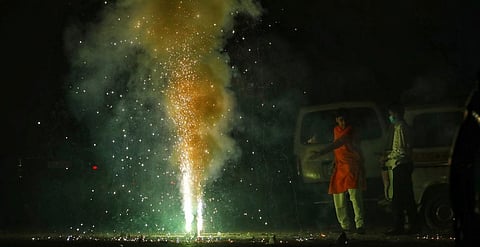

Delhi and the National Capital Region (NCR) have proved pollution monitors wrong after the area registered a spike in the presence of particulate matter (PM) on Diwali night contrary to expectations. Residents of the national capital and its surroundings can now expect to wake up to a smoggy and polluted morning November 5, 2021.
According to the Central Pollution Control Board (CPCB), 21 monitoring stations in Delhi had recorded air quality as ‘severe’ while 17 stations had recorded it as ‘very poor’ till 7 pm November 4 evening.
The Air Quality Index (AQI) represents 24-hour average air quality data. The air quality is considered to be ‘very poor’ when the AQI is from 301-400, according to CPCB guidelines.
An AQI of 0-50 is considered ‘good’, 51-100 ‘satisfactory’, 101-200 ‘moderate’, 201-300 ‘poor’ and 401-500 ‘severe’. Above 500 is the ‘severe-plus or emergency’ category.
At around 4 pm in the evening November 4, Jind in Haryana had recorded an AQI of 447. Hisar, also in Haryana, had recorded an AQI of 452, while Ghaziabad in Uttar Pradesh had an AQI of 419. Delhi itself had an AQI of 382.
Below is the AQI of various cities in the NCR as recorded by CPCB at 8 pm November 4:
City |
AQI | Category |
| Delhi | 404 | Severe |
| Ghaziabad | 440 | Severe |
| Noida | 422 | Severe |
| Rohtak | 412 | Severe |
| Gurugram | 416 | Severe |
| Faridabad | 420 | Severe |
| Panipat | 401 | Severe |
PM2.5 and PM10 had reached emergency levels in Delhi-NCR according to the CPCB’s Central Control Rooms. PM10 levels were around 414 microgram per cubic metre (µg/m³) at 8.30 pm November 4 while PM2.5 levels were 263.3 µg/m³.
The emergency level for PM10 is 500 µg/m³ while that for PM2.5 is 300 µg/m³, under the Graded Response Action Plan (GRAP).
Proving pundits wrong
The worsening of Delhi-NCR’s air quality will come as a surprise to experts, several of whom had predicted that it would not move to the ‘severe’ category.
On November 3, the committee in charge of implementing the GRAP met for the fifth time. Scientists and experts from the CPCB and the India Meteorological Department concluded that Delhi’s air quality would remain in the ‘very poor’ category on Diwali night.
Under GRAP, the Delhi administration is mandated to stop the use of diesel gensets, enhance parking fees by 3-4 times, increase Metro and bus frequency and use water sprinklers if the air quality is ‘very poor’.
It can stop the operations of brick kilns, hot mix plants and stone crushers and make power plants switch to natural gas instead of coal if the air quality is ‘severe’.
It was decided at the meeting to implement norms under the ‘very poor’ category of GRAP.
“The pollution monitors knew that Delhi-NCR’s air quality could become severe on Diwali night. It is unfortunate that steps were not taken accordingly. Given that the novel coronavirus disease (COVID-19) has already weakened the immunity of residents, norms in accordance with the ‘severe’ category should have been implemented,” Avikal Somvanshi, programme manager and expert at Delhi-based non-profit Centre for Science and Environment’s Sustainable Cities Programme, said.
The situation is expected to be worse November 5 and 6 because of the increase in stubble burning in Punjab, Haryana and western Uttar Pradesh as well as the drop in temperatures. It will begin to improve November 7, according to the Indian Institute of Meteorology, Pune.